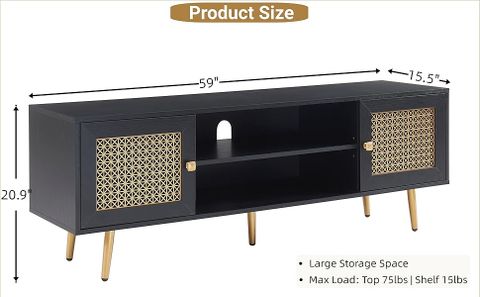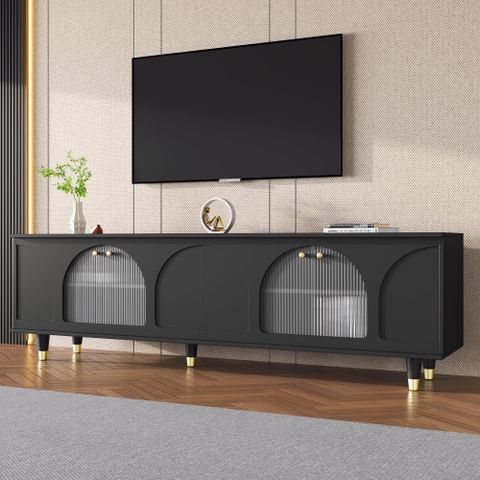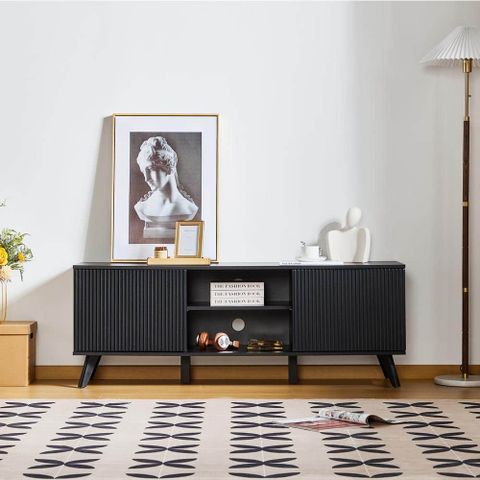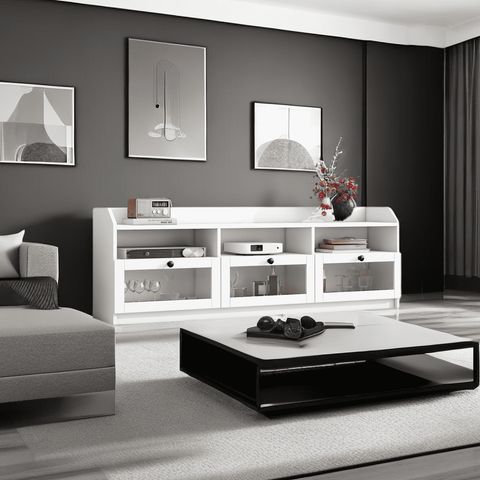Think back to when you were a kid, maybe even your parents’ generation. TV stands weren’t exactly high-tech marvels. They were mostly just wooden shelves or metal frames that held your television and maybe some game consoles. But fast forward to today, and you’d be amazed at what these humble pieces of furniture have become. We’re talking about smart technology integrated into furniture that adapts to your lifestyle, not just holds your screen.
TV stands have been around longer than most people realize. They started out as basic wooden platforms or metal frames, designed simply to hold a television off the floor. But like everything else in our lives, they’ve evolved dramatically. What began as a straightforward functional item has transformed into a complex blend of design, technology, and lifestyle integration. Today’s stands aren’t just about putting your TV somewhere—it’s about creating a statement, managing your entertainment ecosystem, and sometimes even serving as a centerpiece in your living room. This journey from simple to sophisticated shows how much our relationship with technology and home design has changed over time.
The Early Days: Basic Functionality
In the early days of television ownership, stands were incredibly basic. You’d find them made primarily of wood or metal, often with little more than a flat surface to place your TV on. These were typically cheap, utilitarian pieces that didn’t try to do much beyond their primary function. People didn’t expect much from them—just enough space to put the TV and maybe a few accessories. They were often found in corner spaces, or against walls, serving as simple platforms.
There was no concept of cable management or smart features. The focus was purely on holding the television securely and keeping it off the ground. Many of these early stands were built to last decades, though they looked pretty primitive by today’s standards. Some featured adjustable height settings, but that was about it. They were essentially furniture that happened to accommodate televisions rather than being designed specifically for modern entertainment setups.
The Mid-Century Shift: Aesthetic Considerations
As television became more mainstream, so did the desire for better-looking furniture. By the 1960s and 70s, people started caring more about how their entertainment centers fit into their overall home decor. This marked a turning point in stand design. Manufacturers began incorporating more stylish elements—curved lines, different wood finishes, and even some decorative elements.
These stands were still relatively simple, but they showed signs of evolution. The emphasis shifted from just functionality to also looking good. Some featured glass panels, others had unique shapes, and many included storage compartments for games, books, or other items. The idea of having a cohesive look for your living room started taking shape, and television stands became part of that visual story. People began realizing that a well-designed stand could actually elevate the entire room’s aesthetic appeal.
The Digital Revolution: Cable Management and Organization
With the rise of cable boxes, gaming systems, and multiple devices, the demands on TV stands increased significantly. Suddenly, stands had to manage more than just the television itself. This period saw the introduction of cable management features, which were revolutionary at the time. Stand designers realized that keeping cables neat wasn’t just about aesthetics—it was about safety and usability too.
Many new designs incorporated hidden cable pathways, built-in storage for electronics, and even dedicated spaces for audio equipment. This was when people first started thinking about stands as complete entertainment solutions rather than just TV holders. The focus shifted toward organizing the chaos that came with digital entertainment. Stands now needed to accommodate multiple devices while maintaining clean, uncluttered appearances. This was a major step forward in terms of both design and functionality.
Modern Design Integration: Multi-Purpose Spaces
Today’s TV stands reflect our increasingly connected lives. They’re not just about holding a television anymore—they’re about creating versatile spaces that serve multiple purposes. Modern stands often include features like built-in lighting, adjustable shelving, and even smart home integration capabilities.
Some stands now come with wireless charging pads, USB ports, and even speakers that connect directly to your television. The idea of a single piece of furniture managing multiple aspects of your entertainment experience has become very common. Designers have also started focusing on how stands can integrate with other furniture in a room, creating cohesive looks that work with existing décor rather than fighting against it. This represents a shift from viewing stands as separate items to seeing them as part of a larger interior design strategy.
Smart Technology Integration: The Future Is Now
The latest wave of TV stands incorporates smart technology in ways that would have seemed impossible just a decade ago. These aren’t just smart because they have Wi-Fi connectivity—they’re smart because they adapt to user behavior and preferences. Some stands can automatically adjust their height based on viewing position, while others can recognize when devices are plugged in and adjust accordingly.
There are stands that can dim or brighten lighting based on ambient conditions, or even control your room’s temperature through integrated sensors. Others offer mobile app control that allows users to manage everything from cable organization to device placement. The integration of artificial intelligence has allowed these stands to learn from usage patterns and make adjustments without requiring manual input. It’s fascinating to see how these once-simple pieces of furniture have become sophisticated systems that respond to our daily habits and needs.
Sustainability and Customization Trends
Modern consumers are increasingly concerned about environmental impact, and TV stand manufacturers are responding with sustainable materials and customizable options. Many companies now offer stands made from recycled materials or sustainably sourced wood. There’s also growing interest in modular designs that allow users to customize their stand’s size and configuration over time.
Customization goes beyond just appearance. Some stands now feature interchangeable components, allowing owners to modify their setup as their entertainment needs change. This flexibility means fewer replacements and less waste, aligning with broader sustainability goals. The ability to personalize stands to match specific room dimensions or individual preferences has also become a major selling point. People want furniture that fits perfectly and reflects their personal style, not just meets basic requirements.
Looking back at how far TV stands have come is really quite remarkable. What started as simple platforms for holding televisions has evolved into complex, multifunctional pieces that integrate seamlessly with our digital lifestyles. From basic wooden shelves to smart, adaptive furniture, these changes reflect how deeply our entertainment habits have influenced home design. Today’s stands represent more than just furniture—they’re part of a larger conversation about how we want to live, work, and play in our homes. As technology continues to advance, it’s exciting to think about what the next evolution might bring. One thing’s for certain: TV stands will continue to adapt to meet our changing needs, whether that’s through smarter features, better materials, or more innovative design solutions. The journey from basic storage to smart design solutions isn’t over yet, and it’s one that promises to keep surprising us.














